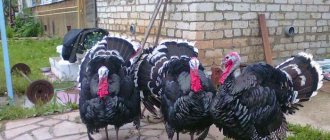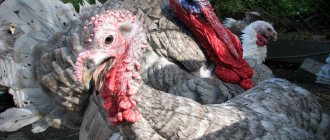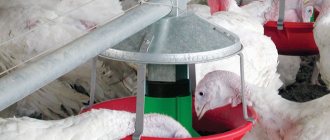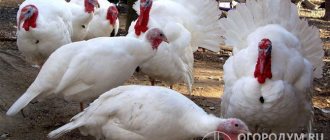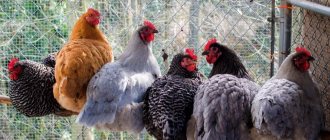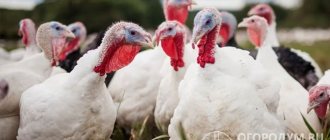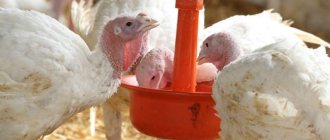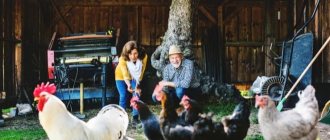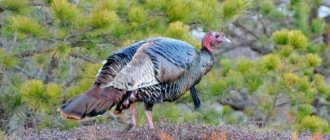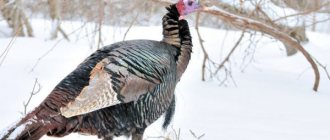Home » Articles about turkeys » Poultry house for turkeys
An existing shed on the site can become a poultry house for turkeys - it needs to be insulated and equipped with everything necessary. In the absence of a finished building, you will have to start construction - wood, foam blocks, and bricks are used to construct the building.
Keeping turkeys in cages: pros and cons
Some breeders criticize cage-based poultry farming because they are raised in an unnatural environment and do not have enough time to graze.
In addition, the poultry farmer is responsible for providing the turkeys with all the necessary food. However, with cellular content there are a number of advantages that cannot be ignored, and these include the following aspects:
- significant feed savings;
- no need for different bedding;
- poultry meat productivity is higher;
- farm areas are used more efficiently;
- You can keep more birds.
However, there are some drawbacks to cage-based poultry breeding. One of them is when turkeys fall on their feet and the bird loses the ability to use its wings. Due to the cramped space, turkeys simply lose the ability to fly and move, and frequent fractures of the leg and wing bones are observed. However, successful attempts are being made to eliminate these shortcomings.
When keeping and breeding turkeys in cages, growth slows down after reaching 2 months of age. This is also due to lack of space. Sometimes turkeys become very frightened when there is extraneous noise near the poultry house. The resulting excitement sometimes ends with turkeys being injured and even killed as the cage block overturns due to panic among the flock.
Turkey poultry project: drawing up a drawing
When the location for the future poultry house has been determined, its drawing needs to be developed in detail. If you make the right calculations right away, you can get a correct idea of exactly how much building materials will be needed. Therefore, drawing up the right project is the key to correctly calculating the budget.
It is also important to decide who exactly needs to be kept - how many adult birds there will be and how many turkey poults. Each building can be made according to different projects, or they can be built within one complex with the possibility of completely separating turkeys from chicks
The size of the turkey poultry depends on the number of birds
Poultry house for turkey poults: drawing
Below are drawings, which were compiled on the basis that 30 turkey poults will live in the turkey house. Parameters for other quantities can be easily recalculated.
Turkey poultry with an aviary: side view
Note! You should not make the room too high, because in this case it will be more difficult to heat it - all the heat will go up
It is also important to take into account that the roof is sloping for precipitation
Turkey poultry: view from the entrance
Turkey poultry: top view and interior design
Poultry house for adult turkeys: drawing
Here is a drawing for keeping the same number of adult birds (30 heads).
Turkey poultry for 30 heads
The presence of a vestibule in a turkey house for any purpose is a prerequisite so that cold air in winter does not directly reach the birds. You can keep household items there so that space doesn’t go to waste, but you shouldn’t skimp on its size.
The inlet hole is selected with standard parameters. And the window opening can be made no more than 50*50 cm. For 30 heads, two such windows are suitable, and they must certainly be located on the same side from the south, southeast or southwest. As for manholes for turkeys, it is better to install them directly under the windows - the birds will instinctively move towards the sunlight and end up in the enclosure.
Aviary
To prevent individuals from becoming obese, to move more and strengthen their immunity, the area of the pen should be taken into account when building or choosing a barn. Active turkeys are not deprived of the ability to fly, so it is necessary to provide fencing for walls and ceilings. The best option for the material used would be a metal mesh with small holes. It is recommended to sow the ground in the enclosure near the barn with perennial (clover, alfalfa) or annual grasses (peas, oats), which will serve as additional food for turkeys. It is necessary to install drinking bowls in the paddock area, especially in the summer. In addition, the breeder must provide a shaded place where the birds can hide from the heat.
Advice! For comfortable winter walks of individuals, the area of the enclosure is covered with several layers of straw, in order to avoid frostbite of the animals’ limbs.
The construction of a barn for domestic turkeys, as well as its internal arrangement, will not cause big problems if you carefully study all the requirements of the birds, the number of expected livestock, the rules for calculation and installation, as well as the necessary investments. A properly designed room will allow individuals to live in normal conditions, calmly share space with neighbors, intensively gain weight, prepare for egg-laying and produce healthy offspring.
How to properly keep turkeys
Turkey poults, when raised at home, require special care in compliance with feeding technology. The storage area must have a bedding made of straw or sawdust. Newspapers are not suitable for this purpose because they are very traumatic for chicks. The temperature is maintained at an average of about 37 C, and lighting must be provided around the clock.
If you are starting to raise turkeys, remember that the water should be warm and changed three times a day. Every 4 days, you must add several crystals of potassium permanganate to warm water. 4 days after the turkeys hatch, the feed should be mixed, balanced and combined.
To do this, novice farmers can purchase ready-made feed, and experienced farmers can prepare it at home. If there is no access to feed or the farm has its own ingredients, the feed can be easily prepared with your own hands: take 60 percent crushed wheat, 30% crushed peas, 10% crushed corn. Boiled hard-boiled eggs, sugar or cottage cheese are added to this mixture before feeding the turkey poults.
When raising turkeys at home, mash with yogurt, potatoes, herbs, fish, cottage cheese and carrots is best. All components must be crushed and have a uniform consistency. They are prepared before feeding so that the mixture does not spoil
All this is important to know for both beginners and professional farmers.
How and what to feed turkey poults
When rearing turkeys at home, you need to feed them seven times a day and feed each person so that there is enough of it or there is no leftover. When the turkey poults grow up, feeding should be reduced to four times, and special vitamin supplements can be introduced. Animal proteins and vitamins A and E must be added to food and drink all year round. The water is changed regularly. In winter, when turkeys are raised at home, greens, sauerkraut, fresh cabbage and tree branches are added to their diet.
After a month, turkey poults become more resilient and easier for beginners to care for. Adult turkeys are generally unpretentious to food, so soon the weight of an adult will reach 40 kg. To raise turkeys at home, you will have to build a separate barn or use a ready-made one in which birds have already been bred. The room for keeping turkey poults should be well ventilated, light, dry and of suitable size. Dampness, frost and drafts will have to be excluded.
Choosing a place to raise turkeys on a farm
To raise turkeys, you will have to install perches at a height of about 80 cm. For each bird, half a meter of the total area of the room should be calculated. One nest is made for five laying hens. The nests are made two-tiered in a darkened area of the barn. The size of the nest should be 70*80 cm. The entrance to the nest should have a threshold for easy entry. Height - 60 centimeters. Turkeys and turkey hens should be kept separate so that they do not interfere with nesting.
The temperature in summer should be maintained at 20 - 22 degrees, and in winter - no lower than - 4. -5 degrees. Sudden changes should be excluded. Make sure that the litter is clean, dry and changed at least a couple of times every 7 days.
During warm periods, turkeys can be released for free range in the morning and evening. To do this, a pen is made in front of the barn with a calculation of 20 meters per turkey. The pen must have a partial canopy. Feeders and drinkers should always be full and clean. The soil in the pen can be sown with herbs, which will be an additional source of vitamins for the birds.
Breeding turkeys at home for beginners can become a real hobby and even generate income from the sale of meat or eggs. Keeping turkey poults on a farm is not difficult, the main thing is to think about their habitat, observe temperature conditions and feeding times.
What should be in the barn
The interior should also be equipped for the birds to live comfortably. Here you need to install the following devices:
- feed containers;
- drinking bowls;
- perches;
- nesting houses;
- ash baths;
- containers for shell rock and gravel.
It is worth considering all of these aspects in more detail.
There are several types of feed containers:
- small troughs;
- grooved structures.
When choosing one option or another, take into account the dimensions of the bird and their height. Feeders are placed at the level of the turkeys' dorsal region. For more rational use, it is necessary to pour food into the container to 1/3 of the total height.
Compound feed is usually given from bunker-type feeders, which are designed for several feedings.
Containers for gravel and other mineral fertilizers are located at a height of about 40 cm from the floor. Add the necessary additives as needed. It is recommended to leave such containers freely available.
Making a separate container for wet mash is not entirely advisable. To save effort and time, it is enough to divide the trough feeder into several compartments with partitions, into which certain types of feed will be poured.
There are a huge number of options for drinking bowls, regardless of the chosen container, it is best placed at the level of the turkey’s neck. To maintain cleanliness in the premises, the drinking bowls are covered with a net so that the birds have no problems getting to the water. The net will serve as a kind of protection against the desire of birds to climb completely into the drinking bowl.
Drinking bowl
With the correct placement of containers for food and water, the turkey house will always be clean and dry, and therefore the owner will not have to spend a lot of time cleaning the room.
Perches are necessary for turkeys to rest and sleep: they are installed in such a way that there is at least 50 cm of perch per bird. The main criteria here are the strength of the sticks and their removal of possible burrs. Perches are installed in the warmest part of the house.
When arranging perches, preference should be given to removable structures that can be easily dismantled during general cleaning.
The lower bars are installed at a height of at least 80 cm from the flooring; the upper bars should not reach the ceilings at the same height. Most often they make a pyramidal version, which saves space in the poultry house. Additional trays are installed under the perches to collect natural waste from birds. This serves as an additional measure to maintain cleanliness in the room.
Nesting houses provide certain conveniences for both bird owners and turkeys. The females will have a place to lay their eggs, and the farm owner will not have to walk around the entire premises to collect egg products.
Turkey nest
The role of nests is given to wooden boxes that are suitable in size for the birds. The number of houses is calculated based on the number of females. As a rule, one nest is required for 5 laying hens, which is best installed in a dark place in the house. The most important design requirement is that it is safe for turkeys.
Ash baths help birds keep their plumage clean. In the summer, you can do without this - it will be enough for the turkeys to take dry baths in the yard. But with the onset of cold weather, it is worth taking care of the presence of wooden boxes with small sides, which must be filled with a sand-ash mixture. This method reliably protects turkeys from the appearance of skin and feather parasites.
Perches for turkeys: DIY building tips
Some poultry farmers do not understand the need to create such places for turkeys, considering them a waste of money. What is the use of perches?
Any bird, like a person, needs a personal place of residence, the role of which is played by the hen. What should it be like? Recommendations for creating it yourself are as follows:
- It is located in the warmest part of the turkey house - in the back.
- The design of this part resembles a regular slide with many rows of different levels. Steps are necessary for conveniently lifting the bird to the height of its place.
- Each cell must have dimensions of 70 by 70 mm and with a line pitch of at least one and a half meters.
- The recommended distance between places is 60 cm. Remember, every centimeter is important here.
- For comfortable removal of straw from the perch, you can make a structure with wheels. How it should look in reality can be seen in a video from experienced farmers.
The placement of hens should be in different rows. If this condition is not met, then there is a possibility that all the birds will choose one place for their purposes.
By looking at the photos of the finished hens, you can make sure that each turkey should have its own nest, the arrangement of which should be taken seriously. It should be located 30 cm above the floor level, with a total height of 50-60 cm. To keep the eggs safe and sound, make a 20-centimeter threshold and cover the bottom with a thick layer of hay.
You can attract the bird's attention by placing one egg or its dummy in the house, because if it is hollow, then the turkey may walk away
Features of arranging a room for turkey poults
Brooders are created and equipped with certain conditions:
- It is recommended to make boxes for chicks from wood. These can be either thin boards, plywood, or OSB panels.
- The design must have fine mesh inserts to ensure gas exchange.
- Brooders are installed at a height of 15 cm from the floor covered with bedding material.
- Inside the box, the temperature in the first 14 days after the chicks are born is regulated at 34 degrees.
- Round drinkers and feeders are installed for chicks, which saves space in the brooder.
Necessary materials
Initially, work begins with transferring drawings to paper and preparing the necessary tools and materials. To work you will need:
- wooden blocks;
- durable mesh (usually metal is used);
- pliers;
- hammer;
- hand saw (better if you have a jigsaw);
- fasteners (corners, screws, nails and others);
- pencil and ruler;
- light bulb, switch and cable;
- plywood is moisture resistant.
Some farmers use old wooden boxes to build brooders. This is also appropriate, but you should not use very old copies. Boards can also develop pathogenic bacteria over time.
You can give preference to other materials that are at hand. For example, thick cardboard, fiberboard, chipboard and other materials remaining after repair are widely used.
How to build a turkey barn
It is a little more difficult to build a poultry barn with your own hands for those who decide to raise turkeys, but there are no impossible tasks here either.
Basic requirements of turkeys
The main difference between a chicken coop and a turkey coop is that the turkey is a more capricious bird. They need more space, more light and warmth. If the temperature in the poultry house drops below +5°C, the turkeys stop laying eggs and begin to get sick. Consider additional lighting and heating for the turkey poultry.
Although stove heating is cheaper, you will have to constantly monitor the stove, add fuel and set up a fence so that the bird does not get burned. Nowadays, infrared heaters are used to heat the poultry house, which have high efficiency and are not dangerous for the birds.
Most often, a turkey shed is built from aerated concrete or foam blocks. It is more expensive than timber and plywood, but more durable and warmer. It is possible to make a common poultry house for all types of birds by simply dividing the building with light partitions, leaving a common yard for walking.
Pouring the foundation and laying the walls
When building a poultry shed from foam blocks, a strip foundation is used.
- Clear the area of debris, remove the top layer of soil, and dig a 20x20 trench for the foundation.
- Mix crushed stone with sand and pour it into an even layer at the bottom of the trench, at least 10 cm high.
- Compact and spill with water.
- After this, you can begin installing formwork and laying reinforcement. For this type of foundation, 6 mm reinforcement is suitable, which is tied with wire and filled with concrete mixture.
- In sunny and warm weather, three days will be enough for the concrete to completely set. Remove the formwork and coat the entire foundation with melted bitumen.
After another day you can start working on the walls.
Reinforcement should be provided on the first row of masonry, on the last and approximately in the middle. To groove the blocks, use a grinder or a special tool. Foam concrete is quite soft and easy to groove.
It would seem that there is no need for an armored belt, since this is just a poultry house, but this is not so. The armored belt protects the walls from cracking and destruction if the soil subsides a little. And it will definitely sag under the weight of the structure. You can save on windows if you immediately insert glass into the opening and reinforce it with polyurethane foam. But in this case, the windows have a purely decorative function, and you will not be able to ventilate the room.
How to make a floor and roof in a poultry house
Depending on your finances, the flooring of your bird barn can be made from a variety of materials. The cheapest and most popular is adobe. Dry clay is mixed with chopped straw, scattered in an even layer and compacted well with a tamper. The layer of clay with straw should be at least 10 cm. On top, dry sand, sawdust, or straw is used as bedding.
A more expensive floor is made of boards and timber laid on a concrete screed. Later it is covered with boards or OSB boards. This floor is beautiful, but it still requires constant care and cleaning. Dampness and traces of bird activity will very quickly render the wooden floor covering unusable.
If you have previously built gazebos or added verandas, then there will be no difficulties here either. The technology for attaching a wooden roof to masonry is exactly the same. Transverse beams are laid between the blocks at a distance of no more than 0.5 m from each other and fastened with cement mortar. After the solution has completely hardened, logs, sheathing, insulation, and the roofing itself are installed.
Heat loss through the roof is the greatest, so do not skimp on insulation and do not leave gaps.
Insulation of buildings and important details
The gas blocks themselves are quite warm, so in warm regions you can do without insulation with mineral wool or polystyrene foam. For ease of installation of internal shelves and for the sake of aesthetics, the inside walls should be lined with OSB boards. Do not throw away the scraps of slabs; they will be useful when arranging shelves for nests in the poultry house and various partitions.
When building a barn for chickens and turkeys, many people forget about creating an exit for the birds, and then they have to spend a long time fiddling around with a grinder, cutting out an opening of the required size
It is also important to plan a walk so that you can safely enter the house to collect eggs without disturbing the walking bird. Feeders and perches can be rearranged, but the location of windows and doors is difficult to change
By spending a little time and money once, you will get a reliable and strong poultry shed for many years, in which your feathered pets will feel and feel great.
Starting a herd
So, decide on the breed, prepare the conditions. All that remains is to buy turkeys. There are several options:
- purchase of hatching eggs;
- acquisition of young animals;
- acquisition of parent stock.
Incubation of turkey eggs
Now you can easily buy imported incubation material (France, Slovakia, etc.) or find it at local poultry farms.
High-quality hatching eggs are the most reliable way to get healthy livestock
Breeding turkey poults yourself does not require special experience or knowledge. The main thing is to choose a good incubator. According to reviews from farmers, the Blitz brand devices (for example, this one on AliExpress) are considered the most reliable, affordable, convenient and versatile. You can raise babies of any bird in them: from quails to swans. Therefore, there should be no difficulties with turkey poults.
During artificial incubation, it is necessary to follow the recommended regimens:
| Day | Temperature(℃) | Humidity (%) | Revolution (once a day) | Ventilation |
| 1-6 | 37,8 | 56 | 4 | No |
| 7-12 | 37,5 | 52 | 4 | 1 time per day for 5 minutes |
| 13-26 | 37,2 | 52 | 4 | 2 times a day for 20 minutes |
| 27-28 | 37 | 70 | No | 1 time per day for 10 minutes |
During the process, ovoscoping is performed at each period to determine infertility or dead embryos. The norm for fertilized eggs is considered to be at least 70-75%.
If the temperature regime was maintained without disturbances, the babies begin to hatch on the 27-28th day. The chicks are left inside the incubator until they are completely dry. Then they are transferred to a preheated brooder.
The advantages of this method are as follows:
- The chicks do not become hypothermic.
- Infectious diseases are excluded.
- Guaranteed purity of the breed.
The disadvantages include :
- The need to purchase an incubator.
- Financial losses on unfertilized eggs.
- Additional time costs.
Buying turkey poults
Most often, farmers use this option for purchasing poultry for breeding or fattening for meat.
Babies are bought at one day old or slightly older
The younger the turkey, the lower its cost. However, raising chicks is often accompanied by losses, especially if there is a lack of experience. Therefore, some novice poultry farmers prefer to buy grown birds (from 2 weeks or more). The survival rate of such turkey poults is much higher. Next, the young animals are sorted: the best are kept for breeding, the rest are sold for meat.
In addition to the increase in price for grown-up individuals, there are other problems:
- the risk of acquiring outbred birds;
- hidden diseases;
- the need for a smooth change in diet;
- the impossibility of verifying the conscientious implementation of vaccination and preventive drinking;
- high probability of hypothermia in babies.
You should buy chicks only from trusted breeders with a good reputation or from poultry farms. Very much attention must be paid to transportation and feeding.
Under no circumstances should turkey poults suddenly change their diet! At first they are given the same food as before, gradually switching to a new one.
Acquisition of adults
This method can safely be called the best in terms of the survival rate of young animals, its cost and confidence in the purity of the breed.
Experienced farmers always leave a supply of young stock until the end of autumn, periodically selling off the surplus. This is not a culled bird, but simply an extra one.
The cost of adult breeding turkeys, depending on the breed, starts from 1000 rubles. Per head. Such costs pay for themselves in the first year.
The survival rate of babies during natural breeding reaches 100%, which also has a beneficial effect on the profitability of turkey breeding
But there are also significant drawbacks. The main one is the dishonesty of sellers. Instead of good producers, the buyer risks purchasing a bird:
- sterile;
- old;
- sick;
- the wrong breed.
It is no secret that adults or even old turkeys of medium and light subtypes are sometimes passed off as young heavy crosses. Naturally, an experienced poultry farmer can easily recognize deception. But beginners often fall for such tricks.
No one will feed adult livestock all winter in order to sell them cheaply in the spring. Therefore, it is recommended to purchase parent stock for breeding in the fall.
Requirements for placing turkey poultry
Before building a chicken coop or any other poultry house, you need to choose a place suitable for the construction of the structure.
Requirements for placing a turkey poultry house:
- the site for construction is chosen to be dry, located on a hill, or with no groundwater;
- open areas allow free passage of sunlight;
- The area should correspond to the size of the turkey house itself, as well as the walking pen.
It is better to build a poultry house for turkeys, as well as the perch itself, taking into account the fact that in the future their population may grow or the breed will be replaced by a larger one, so a reserve area may come in handy.
Choosing a site for construction
When building a building from scratch, it is important to choose the right place where the poultry house will be located. Recommendations for such a place are as follows:
- the presence of a slight elevation (dry area far from groundwater);
- a sufficient amount of sunlight (construction in constant shade should be avoided);
- the place should be spacious so that bird rooms and a walking area can fit in;
- location away from places with large concentrations of people and cars (motorways, garages, gazebos, etc.).
Room for turkeys
Helpful advice: when choosing a site and subsequent construction of a poultry house, you should take care of the availability of additional space. Some farmers start with a small number of livestock, and over time they think about expanding their business and very often face the problem of lack of free space.
How to make a turkey barn
For turkeys to live comfortably, it is necessary to build for them not just a place to sleep, but a real full-fledged house. And for this you will need a number of materials and tools.
Necessary materials
The construction of a poultry shed begins with the preparation of all necessary materials. From the point of view of environmental friendliness, safety and economy, the most suitable building material for the structure is wood. When building a poultry house, consider keeping birds of different species and breeds separately.
In addition to this, you also need to stock up on:
- concrete;
- cement.
Find out if you can trim turkeys' wings and how to stop turkeys from fighting.
Tools for work
During construction work, the following tools will be required:
- measuring instruments: construction level, tape measure;
- Bulgarian;
- fastening elements: self-tapping screws, nails, screws, metal corners;
- saw and hammer;
- drill and screwdriver.
Example of a poultry house with sections for chickens and turkeys
Step-by-step instruction
In order for the future building to serve for a long time and perform all the functions assigned to it, all the subtleties of technology should be taken into account when carrying out work.
Find out how to keep chickens and turkeys together.. The construction of a turkey house is carried out according to the following algorithm:
- Pouring the foundation. The foundation is the basis of the poultry house, so it must be as strong and reliable as possible. Filling is carried out using classic tape technology: a trench is dug at least 0.5 m wide and filled with prepared concrete mortar. The concrete is carefully leveled and left to harden for several days.
- Walling. The optimal method for constructing walls is considered to be a frame structure, for the formation of which load-bearing beams are placed on the foundation, an upper joist is installed and vertical beams are mounted at appropriate intervals. All parts are fastened together with metal corners and screws.
- Formation of openings. The next step is to form all the necessary openings: windows, doors, ventilation holes, holes for turkeys, etc. It is recommended to additionally insulate all the holes made using polyurethane foam.
- Roof installation. Next, they begin to install the roof: they form a transverse and counter-lattice, which are insulated with special materials (mineral wool, insulation). It is recommended to lay a vapor barrier film under the insulation layer, since a large amount of moisture will come out of the poultry house.
- Insulation of walls. In order to always have a comfortable temperature inside the room, you need to insulate the walls with materials that allow air to pass through well, which can be mineral wool or ecowool.
Do-it-yourself turkey poultry: video
Turkey roosts
The bird's perch should be smooth
This matter also has its own Requirements. Perches for caged or other turkeys should be smooth and removable. Most often, special perches are placed in the heated part of the barn, so construction can begin there. A perch for a domestic animal may in appearance resemble an ordinary hill, in which the last rows are located higher than the front ones. To build such an important element of the turkey poultry, prepare beams (7x7 centimeters) with slightly rounded ends.
The distance between the bars should be about half a meter, and the perches should be located at a height of 80 cm from the floor.
If you wish, you can place retractable shields under the perches that will help you deal with droppings, and the barn and its inhabitants will be cleaner. If difficulties arise regarding the construction of perches, it is recommended to use drawings, photographs or videos; in them you can learn in detail about all the details and important points that relate to perches for turkeys.
How to make a house for turkeys with your own hands?
To keep turkeys during the cold season, you will need to build a poultry house for them. It is located in a courtyard far from a source of drinking water, on an area that is not blown by winds and is not flooded with melt water. Often the turkey poultry is an extension to the house. This allows you to save building materials, the room will be warmer, but you will need to install additional moisture insulation on the walls of the house.
It is necessary to attach a special paddock (aviary) to the turkey poultry for walking. Turkeys are quite active and the area of the pen depends on the number of livestock - the larger it is, the larger the area required. Building an enclosure is not difficult - it is assembled from several pillars and veins. Then the entire structure is covered with a mesh with cells through which the bird cannot crawl.
An enclosure for walking turkeys
The height of the enclosure should be about 2 meters, since adult turkeys are quite good “flyers”, and even from above, danger in the form of birds of prey can overtake you completely unexpectedly.
Direct production
It is not advisable to build cages for a certain age of birds. Turkeys love large spaces, so the larger the product, the better.
Let's consider a standard cage option. Its dimensions are taken to be one and a half to zero seven meters and the height should be at least zero seven meters. The bird house is made of wooden blocks, with plywood walls and a ceiling screwed to them. The door is attached to the front side.
When making it, it is necessary to provide viewing windows for light to enter and control birds
Attention should be paid to the floor covering. In our case, it will be a metal mesh; under it you need to place a raised floor in the form of a plastic pallet
- First of all, we make plywood walls. To do this, two plywood sheets measuring one and a half by one and a half meters are cut into two identical parts. We should get four pieces of plywood measuring one and a half by zero seventy-five meters. Two pieces are the finished ceiling and the far wall. The remaining two pieces still need to be sawed in half. The resulting squares are the sidewalls.
- Next, you should build a wooden frame to fit the manufactured wall dimensions. Then we screw the prepared plywood pieces to the frame with screws.
- The cage is almost ready, all that remains is to make the floor and the door. To make the floor, you need to build a frame from the bars equal to the perimeter of the bottom of the cage. Next, the mesh is stretched over the frame.
- The pallet is made in a similar way, only sheet plastic is attached to the place of the mesh. It can be replaced with moisture-resistant plywood.
- The door is made in the same way. Handles are screwed to it, and it is attached to the cage using loops.
About
Brooder Tools and Materials
The stages of work are standard and correspond to the construction of a regular utility room. The differences are associated with additional insulation measures, as well as the internal arrangement of the poultry house - ventilation, heating, perches and much more:
- Laying the foundation.
- Construction of walls and roofs.
- Roof laying.
- Installation of openings for windows and doors.
- Flooring.
- Internal and external wall finishing (insulation, vapor barrier).
- Internal work on organizing space in a turkey poultry house.
- Installation of an aviary for walking birds.
Wood is the best option for building a turkey poultry house
As for materials, as already mentioned, wood is the best choice in terms of environmental friendliness, durability and affordability. Often such structures are also built from cinder blocks. The pace of construction in this case is faster. It is worth considering that cinder blocks, however, will quickly become damp. In addition, they release more heat than wooden walls. A typical concrete solution is used for the foundation.
We invite you to read: Who should not eat tomatoes: 8 prohibitions from doctors, - harm to tomatoes, who should not eat tomatoes, benefits and harm of tomatoes - latest health news
You will also need ordinary construction tools and measuring instruments:
- building level and tape measure;
- drill, saw, screwdriver;
- nails, screws, metal corners;
- Bulgarian;
- hammer and others.
The set of tools is standard and can be found in any household
Jigsaw
If you decide to make a brooder on your own, you will need:
- regular saw or electric jigsaw;
- hammer;
- screwdriver;
- roulette;
- pliers;
- screws.
Brooder layout and dimensions
You can assemble a brooder with your own hands from any available materials. There are brooders that are made of cardboard or plastic. In fact, it is much more practical to use more durable materials. For the frame, wooden beams or multi-layer cardboard are most often used. Some people use seedling boxes for this purpose.
Brooders with plastic mesh
General points
For a chicken or turkey to lay eggs well, it must be healthy.
That is why it is so important to pay enough attention and effort to building a high-quality, strong and warm poultry shed. Most novice farmers do not dare to have livestock due to the lack of suitable premises for their maintenance, believing that they cannot afford to build from scratch. However, if you carefully study the issue, which is what we will do in this article, it will become clear that building a good-quality chicken coop is not only not difficult, but also not so expensive
However, if you carefully study the issue, which is what we will do in this article, it will become clear that building a high-quality chicken coop is not only not difficult, but also not so expensive.
Choosing a location for a bird shed
First of all, you need to choose the right place for construction. In this case, it is necessary to start not only from considerations of the square footage of the future barn. Keep in mind that poultry waste products emit a rather strong unpleasant odor, so if the barn is located on the leeward side, the odors will constantly be directed towards the residential building. It is best to place sheds for animals and poultry at a sufficient distance from residential buildings next to a toilet or cesspool.
The dimensions of the object being built are directly affected by the free area of the site. The best place to build a shed is on a small hill, then in the cold it will not need to be heated additionally, and in the warm season it will warm up faster. In addition to the space for the barn, it is necessary to allocate an area for walking poultry - this is a prerequisite for the comfortable and healthy well-being of pets. Its area should exceed the area of the barn itself by 2-3 times.
You can build a chicken coop using existing plans developed by professional builders and experienced farmers, or you can take one of them as a basis and create your own unique poultry shed design, ideal specifically for your site. At the end of the article you will find several examples of chicken coop designs.
Bird shed dimensions
Poultry is quite unpretentious in keeping, but this does not mean that it does not need care and attention at all. Remember, the more comfortable your chickens and turkeys live, the better they will lay eggs. In this part of the article you will learn how to arrange a poultry barn according to all the rules.
The chicken coop must be durable, warm and safe. This is a kind of smaller copy of a residential building, the residents of which should feel safe and comfortable in it. It must have ventilation and lighting. It is not at all necessary to conduct electricity there - you can install several windows for natural light.
Birds are social animals, but they still require personal space. Otherwise, strong individuals will begin to dominate the weak, peck at them and fight. To avoid this, it is better to think in advance about how many chickens will permanently live in the barn and, based on this, calculate the area of the room. No more than 4 chickens or 3 turkeys can be placed per 1 m².
Inside the barn you need to install nests, perches, feeders and drinkers. It is best to place the perch as far as possible from the front door, since the bird will rest there, and therefore it is better not to disturb it again. In this case, the perches should be slightly inclined, but just enough so that the chickens can move freely along them. Usually, to make a perch, wooden beams with a diameter of up to 5 cm are used, the upper part of which is rounded so that it is convenient for the bird to clasp the pole with its paws. The beams are installed parallel and in several tiers, maintaining a distance of at least 25 cm (up to 40 cm), between the floor and the lower beam there should be 40-50 cm. Experienced farmers advise making a perch in 4 tiers, attaching the beams to the walls using hinges.
As for the equipment of nests where birds will hatch eggs, you can use wooden boxes (for vegetables and fruits) or baskets to make them. Use hay or straw as soft, warm bedding, which is periodically replaced with fresh one. One nest can accommodate 3-5 laying hens.
At the bottom of the barn door you need to make a closable hole (miniature hole) approximately 30 cm high. It is necessary for the birds to freely exit to the walking area.
So, based on the above information, you can calculate the exact dimensions of the future chicken coop and walking area. A barn for 10-20 chickens will occupy an area of 2x3 m, and the walking area should be several times larger.
How to make a floor in a poultry house?
The floor deserves no less attention. Its arrangement must be carefully considered
The floor in the turkey house should be level, warm and smooth. If you make the floor with a mesh, then the paws of the young animals may fall through the mesh. When building a floor in a barn, it is recommended to retreat about 20-25 cm from the ground. A poultry house for turkeys should be equipped, in addition to the floor, with windows, through which sunlight will flow, which has a good effect on the birds and their development. Windows should be located so that during the daytime the floor over its entire area is illuminated by daylight.
If you comply with such needs of turkeys, they will thank you by being less sick and growing actively, in addition, turkeys will lead a healthy lifestyle. In addition to properly positioned flooring and windows, you also need to think about special loopholes. Exits must measure 50 by 50 centimeters. Thanks to such exits, birds can easily move not only within their place of residence, but also outside it. To maintain normal heat inside the turkey poultry, the openings are equipped with double dampers.
A few words about walls, floors and window openings
The floor can be called the main part of the room, because turkeys will walk on it most of their time. To avoid problems with limbs in birds, you need to adhere to the following parameters:
- Smooth surface;
- absence of knots, cracks, etc. on the boards;
- warm.
If there should be no difficulties with installing a flat and smooth surface, then questions may arise with the necessary heat. The floor covering is placed above the ground at a distance of at least 25 cm. Thanks to this height, the floors will not freeze during frosts.
You should not rely only on artificial lighting of the poultry house, and therefore it is necessary to make window openings. Lack of daylight leads to diseases in birds. To make it clear how to arrange windows, you can look at a simple example. Regardless of the location of the windows, all corners of the room should be illuminated. If this rule is followed, then the chosen scheme is correct, and there will be enough light for all birds.
Windows in the turkey poultry
As for the walls, there are some subtleties here: they must be smooth and retain heat. Also, special holes will be installed in the walls through which the bird will go outside. Its dimensions depend on the size of the birds. For medium breed groups, 50x50 cm is sufficient. Each hole must have special doors that are closed at night so that the birds are not disturbed by drafts.
We build with our own hands
Construction work for the construction of a turkey poultry barn is standard and corresponds to the construction of any premises for utility purposes. Before starting work, you need to prepare a design project indicating all dimensions. Then the building material is selected and an estimate is drawn up. Next, everything necessary for construction is purchased and tools are prepared.
Materials
The choice of material depends on the service life of the structure and the financial capabilities of the poultry farmer. The following materials can be used to build a turkey poultry house:
- tree;
- brick;
- aerated concrete blocks.
Wood is considered the most inexpensive and environmentally friendly material. In addition, the construction of a wooden structure does not require professional mason skills and it can be made independently. A structure made of brick or aerated concrete blocks is more durable, but is built slowly and requires experience.
A brick shed will be a source of dampness, so you need to take care of ventilation and insulation of the walls.Tools
When building a turkey poultry house, you will need the usual set of construction tools:
- tape measure and level;
- shovel;
- Master OK;
- hammer;
- drill;
- screwdrivers.
For interior work, you may need a wood hacksaw, plane, chisel, pliers and wire cutters. To connect wooden structures, nails, screws, self-tapping screws and a metal corner are used.
Work plan
All work on the construction of a poultry house for turkeys is divided into several successive stages:
- laying the foundation;
- walling;
- roof installation;
- installation of doors and windows;
- floor production;
- external and internal finishing;
- equipment installation;
- construction of an enclosure for walking.
Step-by-step construction
The basis of any capital structure is the foundation. A ribbon design is suitable for turkey poultry. First, according to the size of the structure, a trench with a width of 50 cm is dug and a cushion of sand and gravel is laid. Then the formwork is installed, which should be 15-20 cm above the ground level. If the structure is small, then a columnar foundation can be made. After the solution has completely hardened, you can begin building the walls. For self-construction, a wooden frame structure is best suited.
Design design with dimensions.
Load-bearing beams made of profiled timber are laid on the foundation, on top of roofing felt. Next, the frame of the structure is assembled using metal fasteners. The walls along the frame are covered with clapboard, taking into account door and window openings. The space between the inner and outer walls is filled with insulation. Mineral wool is usually used for this purpose. The brick building is erected in one row, also taking into account the openings. The walls should be insulated with sheets of polystyrene foam or extruded polystyrene. When installing the roof, a vapor barrier is placed under the insulation. The floor can be laid with boards or a cement screed.
Lighting Features
This parameter plays an important role in the life of birds. For turkeys, lighting time (duration of daylight) should be at least 13 hours. In the summer months, there is no need for additional devices that provide light, but with the onset of autumn and winter, the need for lamps already appears. To do this, you will have to equip the house with electrical wiring and lamps.
Lighting in the poultry house
To illuminate the room, you will need simple incandescent lamps with a power of 60 W (they can be replaced with LEDs that have similar indicators). The minimum illumination is 6 W per square meter. When autumn comes, the lights are turned on at the same hours:
- from 6 a.m. until full dawn;
- with the onset of dusk until 20 o'clock.
During the daytime, the lights are turned on if it is very cloudy outside; the rest of the time natural light is used.
Microclimate
Despite their unpretentiousness, turkeys need comfortable conditions. In this case, they do not get sick, develop well and quickly gain weight. The microclimate is determined by several factors.
Lighting
The duration of lighting is very important for the proper development of turkeys. They require 12-14 hours of daylight. In summer, artificial lighting is not required, but in autumn and winter it is turned on daily, and at the same time. Optimal illumination is 10 watts per square meter of area.
Ventilation
Due to the unpleasant odor and caustic substances released by feces, a window may not be enough for good ventilation of the room, so supply and exhaust ventilation should be provided. In a small turkey house, it can be organized from two asbestos-cement pipes passing through the roof of the room and located at different levels.
Temperature in winter
Adult turkeys are quite resistant to low temperatures, however, the bird house must be heated in winter. For this purpose, you can use an electric convector or an infrared film heater. If the room is well insulated and small in size, then the heat source can be electric lighting lamps.
Insulating the chicken coop
You can insulate a turkey poultry house with various materials. The gap between the walls is filled with mineral wool. To insulate the walls, polystyrene foam, foamed polystyrene and sheet foil insulation such as Penofol, Ecofol or Izover are used.
Litter
Various organic components can be used as bedding. This is sawdust, straw or peat. First, a layer of lime should be poured onto the floor, on which the bedding should be laid.
Interior work
The construction of the poultry house frame is not the end of the construction work, because then it is necessary to carry out a number of measures for the interior decoration of the premises, the organization of lighting, heating and ventilation.
Lighting
Turkeys should have about 13 hours of daylight, so it is very important to provide adequate lighting in the house. To do this, electrical wiring with lamps is installed. In summer, additional lighting is not required, and in winter and autumn, ordinary 60 W fluorescent lamps or LED lamps are used.
In summer, additional lighting is not required, and in winter and autumn, ordinary 60 W fluorescent lamps or LED lamps are used.
Find out how long turkeys grow before they are slaughtered.
- in the morning: from 6:00 to dawn;
- in the evening: from first twilight until 19:00.
Ventilation
Simply installing several windows in a poultry house will not be enough for a comfortable stay for turkeys, so you cannot do without installing a supply and exhaust system - an installation that ventilates air due to its forced removal.
Important! The arrangement of supply and exhaust ventilation is a mandatory measure if the premises will be inhabited by birds of foreign breeds. Such birds are very sensitive to high humidity, dampness, and air pollution, as a result of which they often get sick and reduce their productivity.
To do this, even during the construction of the barn, a special box measuring 25x25 cm is installed, which is equipped with three exits: to the floor of the turkey house, under the ceiling and in the middle
In this case, the shaft pipe for ventilation is led out into the street.
To do this, even during the construction of the barn, a special box measuring 25x25 cm is installed, which is equipped with three exits: to the floor of the turkey house, under the ceiling and in the middle. In this case, the shaft pipe is led outside for ventilation.
When installing pipes, cracks in the wall should be filled with foam.
Temperature
One of the most important conditions for keeping turkeys is maintaining a comfortable temperature. To do this, you should create an internal heating system, as well as high-quality insulation of walls and floors.
The floor should rise above the ground by at least 20 cm, and if the birds are kept in harsh climatic conditions, then at least 40 cm. In this case, it is recommended to use hay, sawdust, and straw as bedding material, which are covered with a layer of 10–15 cm.
Find out what the temperature should be for turkey poults.
To form the flooring, experts advise using wooden blocks that fit tightly together. It is not advisable to use concrete for flooring, since although it is durable, it becomes very hot in the cold, thereby quickly cooling the air inside.
Of course, during the cold season it is necessary to install additional heating devices in the poultry house. To do this, you can use infrared lamps, which are low cost and can quickly heat the air.
Did you know? The characteristic “whooping” is characteristic exclusively of male turkeys. They make such interesting sounds for several reasons: firstly, they thus attract a turkey, and secondly, they warn other males that the territory is occupied.
As an alternative equipment, you can use traditional air heaters or modern film heaters. When keeping young animals in winter, heating lamps are installed directly above the box, where they are located in the first weeks after incubation.
A modern heating option is infrared lamps
Breed selection
Before you get turkeys for breeding, you need to decide on the breed. For beginners, especially for those who are trying their hand at poultry farming for the first time, it is recommended to take ordinary village birds. Such babies or the parent herd can be found among friends or through advertisements. This bird is distinguished by excellent immunity, unpretentiousness in matters of feeding, and also forgives many mistakes in its conditions of detention.
If you have a little experience, an unpretentious purebred bird will be a good choice. Of the breeds adapted to the middle zone, we can recommend the following: “Bronze Broad-chested”, “Slate”, “North Caucasian”, “Moscow”.
Based on the “Bronze Broad-chested”, various breeds and crosses have been developed that are well adapted to the climate of individual regions
Having gained sufficient experience, it makes sense to try breeding broiler turkeys.
Broilers, contrary to many articles on the Internet and the assurances of bloggers, have very weak immunity. They react negatively to any violation of housing and feeding standards. And the requirements are most often quite strict: strict temperature and light conditions, clear rationing of the diet, timely drinking and other nuances. Neglecting at least one of the points can result in the death of the entire herd in a very short time, which becomes a bitter lesson and implies significant financial losses.
The next important point to guide your choice is the main purpose of keeping the bird.
If breeding work is planned, then it is not possible to achieve success with every breed within the framework of a household plot:
- not all breeds, especially crosses, are bred “in themselves”;
- for subtypes that are too large, artificial insemination will be required;
- it is necessary to take into account the popularity of the breed in the region in order to simplify the possibility of acquiring new producers.
Issues of artificial insemination often have to be resolved with the help of professionals
Some poultry farmers do not take into account the above factors, which leads to additional costs for the purchase of specialized equipment, long-distance travel to find new producers, additional training, etc. Ultimately, when faced with difficulties and disappointments, they simply stop doing breeding work.
Where to build on the site
It is important not only what the poultry house will be like, but also where it will be located.
If it is possible to choose a place for construction, then preference should be given to a site that:
- located in a sufficiently lit place, since it is unacceptable to build a barn in places of constant darkness;
- is located on a hill or on a piece of land where groundwater runs quite deep;
- has a large area, which is enough to build the poultry house itself and a special walking area for birds;
- located far from various outbuildings: garages, bathhouses, summer kitchen.
Check out the guidelines for keeping turkeys in winter.
Feeding the young
At an early stage of life, the bird must be fed properly, paying attention not only to the quality composition, but also to the rules of food intake:
- The food is poured into a tray with small side walls.
- It is necessary to interest the chicks by attracting attention by tapping your finger on the bottom of the tray.
- After 5 days of life, you can add some chopped greens to the feed mixture to attract the turkey’s attention with bright colors.
- Be sure to install automatic drinkers, which are placed above the floor on a wooden stand or other type of elevation.
After the 5th day of life, the tray is removed and the usual long troughs are used instead. All feeders should be equipped with horizontal bridges that prevent contamination of the feed with foreign impurities.
conclusions
The construction and installation of a wooden turkey coop (a chicken coop for keeping the heads of turkey poults or a hen) according to the drawing can be done even by an inexperienced poultry farmer. When constructing a capital structure (for example, in a mine) on a farm, you should provide for the growth of the livestock, and decide whether turkeys are bred for yourself or for sale, make a summer pen if necessary, it doesn’t matter if you are breeding in Siberia or Lomov. Particular attention should be paid to how to properly maintain: lighting, heating and ventilation; After purchasing new individuals, they should be kept in quarantine.
You can read about turkey breeding for business here.
Setting up a turkey poultry house
Perches, feeders, drinkers and nests are placed inside the turkey poultry. Before installation of feeders and drinking bowls begins, lighting is installed. But the ventilation is installed together with the ceiling and roof. If installation of a fan is provided, then it is performed at this stage. To prevent insects from entering the turkey poultry, the ventilation ducts are covered with a special mosquito net.
The mesh is also installed on the windows, if provided. Since in the wild, males and females live separately after the mating season, the turkey poultry should be divided into 2 sections: one for turkeys, the other for turkeys with their offspring.
